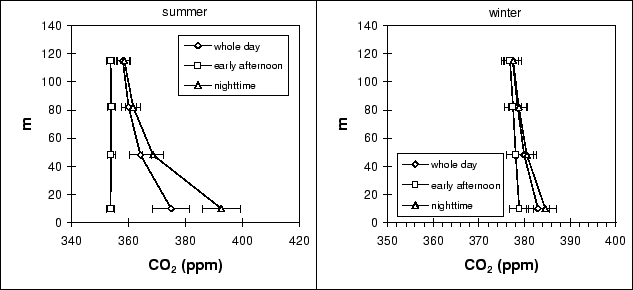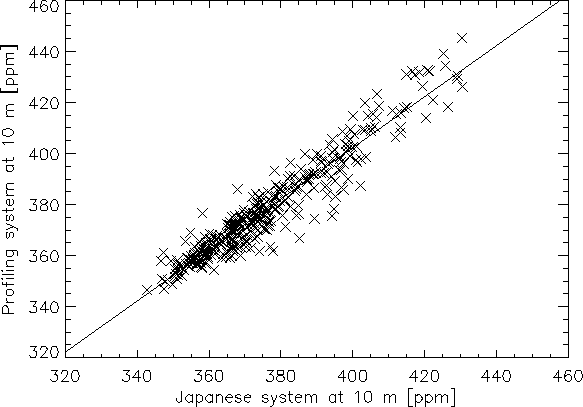Haszpra (1999a) presents time series and average vertical gradients of CO![]() mixing ratios at the site, and a comparison of CO
mixing ratios at the site, and a comparison of CO![]() data from the Hegyhátsál
tower with data from the WMO/GAW K-puszta site in central Hungary.
data from the Hegyhátsál
tower with data from the WMO/GAW K-puszta site in central Hungary.
The weekly flask samples collected for analysis by NOAA/CMDL provide an independent
check on the calibration of our CO![]() mixing ratio measurements. The
relationship between flask measurements and simultaneous in-situ data (with
a few outliers rejected) does not differ significantly from 1:1 (slope = 0.945,
residual standard deviation = 2.2 ppm, n = 104, data not shown). The large RSD
reflects the high degree of temporal variability of CO
mixing ratio measurements. The
relationship between flask measurements and simultaneous in-situ data (with
a few outliers rejected) does not differ significantly from 1:1 (slope = 0.945,
residual standard deviation = 2.2 ppm, n = 104, data not shown). The large RSD
reflects the high degree of temporal variability of CO![]() mixing ratios
at our site and the difficulty of matching the flask and in-situ data exactly
in time. The data are available on the Internet via anonymous FTP (NOAA CMDL
ftp site, 2001).
mixing ratios
at our site and the difficulty of matching the flask and in-situ data exactly
in time. The data are available on the Internet via anonymous FTP (NOAA CMDL
ftp site, 2001).
The long term, high precision concentration profiles give insight into the biochemical
processes of the vegetation. High CO![]() concentration accumulates close
to the surface during nighttime in the growing season due to respiration, which
is flushed out to the upper atmosphere during the morning transition period,
when the nighttime inversion breaks up (Figure 3 in Haszpra, 1999a). This behaviour
must appear in the measured vertical fluxes.
concentration accumulates close
to the surface during nighttime in the growing season due to respiration, which
is flushed out to the upper atmosphere during the morning transition period,
when the nighttime inversion breaks up (Figure 3 in Haszpra, 1999a). This behaviour
must appear in the measured vertical fluxes.
Figure ![]() shows the vertical profiles of carbon dioxide in
winter and summer, in different time of the day. The summertime plot demonstrates
the accumulation of CO
shows the vertical profiles of carbon dioxide in
winter and summer, in different time of the day. The summertime plot demonstrates
the accumulation of CO![]() during night, and the carbon uptake of the
vegetation during daytime (CO
during night, and the carbon uptake of the
vegetation during daytime (CO![]() concentration is lowest near the ground
during daytime). The wintertime plot indicates the effect of accumulated carbon
dioxide during the dormant season when respiration and soil CO
concentration is lowest near the ground
during daytime). The wintertime plot indicates the effect of accumulated carbon
dioxide during the dormant season when respiration and soil CO![]() efflux
are the main determinatives of the carbon balance.
efflux
are the main determinatives of the carbon balance.

|
Since the objective of the present study is different from the above, no further details are presented here about the profiles, but simply refer to Haszpra (1999a).
Figure ![]() shows the comparison of the CO
shows the comparison of the CO![]() concentration
values measured by the profiling system at 10 m and the concentration values
measured during the profile (or concentration) measuring periods of the Japanese
system. The plot was produced using all available data from the Japanese system.
The corresponding values were chosen such that the time difference between the
time stamp of the Japanese data relative to the profiling data was less than
8 minutes. The Japanese data were averaged for 15 min intervals.
concentration
values measured by the profiling system at 10 m and the concentration values
measured during the profile (or concentration) measuring periods of the Japanese
system. The plot was produced using all available data from the Japanese system.
The corresponding values were chosen such that the time difference between the
time stamp of the Japanese data relative to the profiling data was less than
8 minutes. The Japanese data were averaged for 15 min intervals.

|
The slope of the linear regression is 1.00154, and the intercept is 1.63, r=0.954. This indicates that the measured values are well correlated.